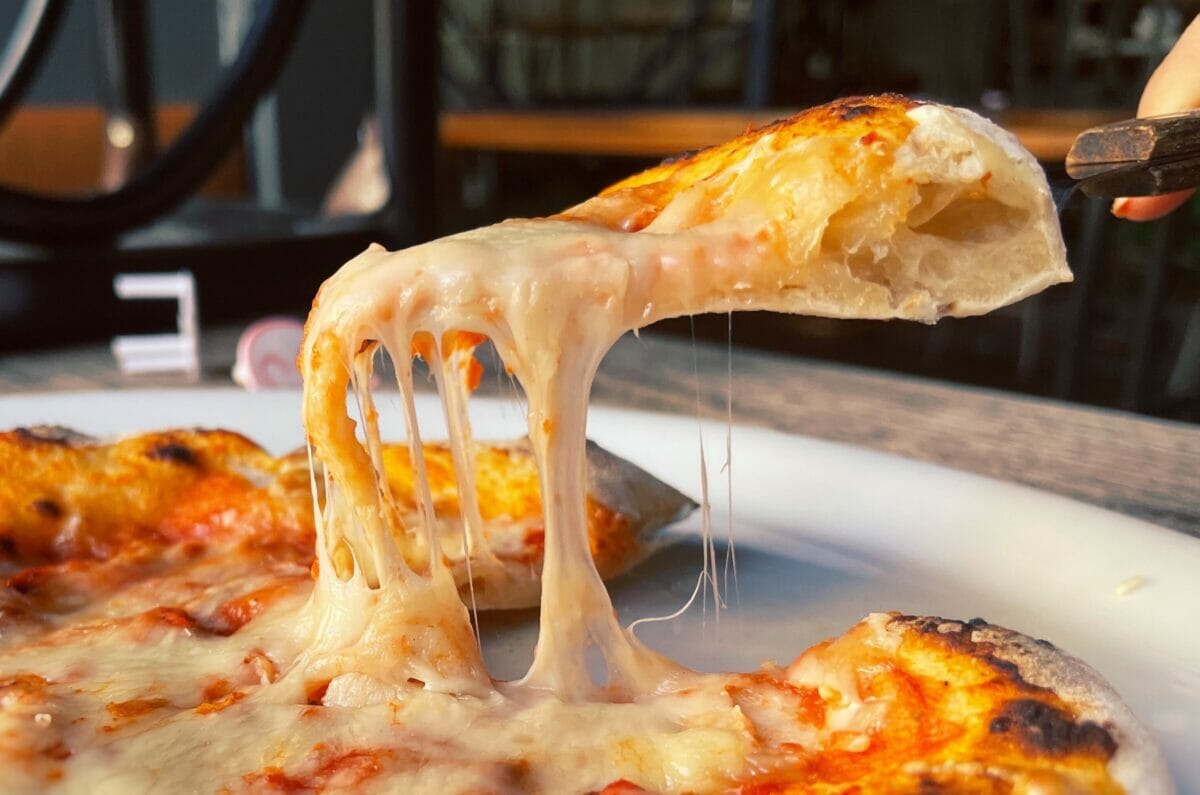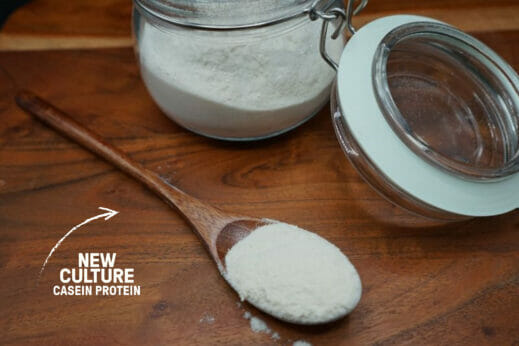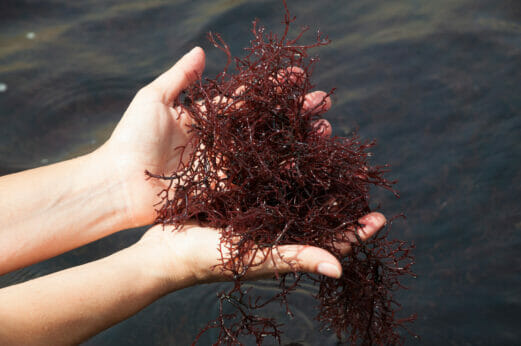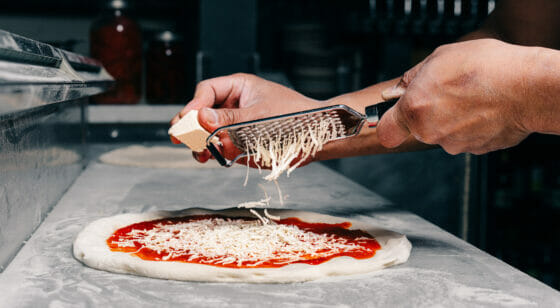Microbes, Mealworms and Seaweed Could Inform the Future of Cheese
Cheese has a hefty environmental footprint. Now, researchers are investigating ways to innovate one of our favorite foods—with help from some unlikely suspects.
Microbes, Mealworms and Seaweed Could Inform the Future of Cheese
Cheese has a hefty environmental footprint. Now, researchers are investigating ways to innovate one of our favorite foods—with help from some unlikely suspects.

Pizza made with New Culture's animal-free mozzarella.courtesy of New Culture.
What makes a good mozzarella?
It has to be flavorful. It should become gooey and stringy when melted. It needs to perfectly balance an acidic tomato sauce.
But does it have to be made from animal dairy?
The cheese innovators over at New Culture would say no. Their first product, a mozzarella cheese created with casein protein made through precision fermentation—that is to say, not from a cow—is launching in Nancy Silverton’s Pizzeria Mozza in Los Angeles in 2024. Silverton and Pizzeria Mozza have received numerous accolades over the years, including the 2014 James Beard Foundation Award for Outstanding Chef.
Precision fermentation is the process of engineering microbes to make something specific during fermentation. Inja Radman, co-founder and Chief Scientific Officer of New Culture, says its microbes are experts at making casein, a protein found in mammalian milk that’s full of nutrients for animal offspring. It also happens to be the protein that gives cheese, well, its cheesiness. The melt, chew, crumble and ooze of cheese are all thanks to casein.
“Everything we know and love about cheese really comes from casein,” says Radman. By making milk protein without milk, Radman and the others at New Culture are making “cow cheese without the cow.”
New Culture is part of a wave of scientists and innovators asking how the future of cheese will look. Some, like New Culture, aim to reduce or eliminate the dairy component altogether, while others seek to improve the dairy cheese process overall using unexpected allies.

Sea cheese
One day, you might be able to buy cheese made with help from an unlikely source: seaweed.
A critical first step in making cheese is coagulating milk. In traditional cheese-making, this happens thanks to rennet, an enzyme derived from calf stomachs. But there’s not enough rennet to meet the global demand for cheese, so most cheeses in US commercial markets are made using alternatives. These alternatives have their own shortcomings, says Jian Zhao, associate professor in the School of Chemical Engineering at the University of New South Wales and one of the researchers looking for rennet alternatives. For example, the taste doesn’t quite hold up to traditional cheese.
“There is a continued need for the industry to explore new alternatives,” says Zhao.
In a recent research project, Zhao and his team turned to the ocean to look for an enzyme that could interact with milk similarly to rennet—coagulating it within an efficient timeline. They weren’t the first to consider the ocean as a potential provenance for this enzyme, but they took the research furthest, isolating a particular species of seaweed called Gracilaria edulis and actually using it to make cheese.

Of the seven seaweed species they tested, G. edulis was the only one to quickly coagulate cheese. The researchers used it to make two cheeses, an aged cheese similar to cheddar and a fresh one more like ricotta, and they were given to a taste-testing panel.
The cheddar was too bitter, says Zhao. But the ricotta? “The quality is quite good,” he says.
You won’t see seaweed ricotta in stores just yet. More research needs to be done to show that seaweed enzyme cheese can produce a product on par with other cheeses. Then, says Zhao, they’d need adventurous cheesemakers to start trying it out.
When it comes to making “sea cheese,” as Zhao calls it, it’s more than likely there are other enzymes in the ocean waiting to be identified.
“I’m pretty confident there are more species which will have the ability to coagulate milk,” says Zhao. “And they potentially can do a better job than Gracilaria.”
Hybrid cheeses split the difference
Clara Talens, senior researcher at AZTI, a Spanish research center that focuses in part on food innovation, sees a future for hybrid cheese.
Hybrid cheese—a milk-based cheese supplemented with plant-based ingredients—can help ease the transition toward more plant-based products, says Talens. The presence of milk makes the cheese’s taste and texture familiar to consumers, but the environmental impact is lower because it uses less dairy. Cheese has a hefty environmental footprint, due to the land use and greenhouse gas emissions associated with dairy farming.
“If we keep feeding our world with animal-derived proteins at the pace we are now, it’s not possible to feed us all,” says Talens. That doesn’t mean eating animal protein is inherently bad, she says, just that the rate is unsustainable.
Added proteins can come from sources such as insects or pulses such as chickpeas. In a recent study, Talens and her team used insect flour made of mealworm larvae and flour made of faba beans (also sometimes called fava or broad beans). These ingredients were chosen because they are high in protein but are not as resource-intensive to cultivate.
“It’s a matter of the resources needed to produce a kilogram of protein,” says Talens.

Talens analyzed different ratios of milk protein to faba bean protein to insect protein. The researchers looked to both dairy cheese and plant-based cheese as reference points, analyzing the resulting mixtures for their nutritional value, taste and texture.
The researchers found that the texture of the faba bean was good, especially when combined with the milk protein. The insect protein did not contribute well to structure, but it gave the cheese an umami-like taste similar to certain aged cheeses.
Another group of researchers from Denmark also looked at the potential for incorporating plant proteins to make hybrid cheeses, and concluded that this area shows great potential—once cheeses are developed that offer satisfactory taste and texture. And in the US in 2021, cheese company The Laughing Cow tried out the concept by releasing hybrid spreadable cheeses that included lentils, red beans and chickpeas.
Still, says Talens, instead of striving to create direct imitations of traditional cheese, maybe another mindset shift is in order.
“We should open our minds and accept all the flavors and other tastes that are produced by using other raw materials,” says Talens. “But still, that’s the most difficult part. With the hybrids, maybe we are a bit closer to acceptance.”
Cheese for everyone
Once the microbes at New Culture make casein, it’s combined with plant-based fats and other ingredients and made into cheese using a similar process to standard cheesemaking, thanks to the fact that the microbially made casein performs the same as casein from cow milk.
“It’s identical to casein we would get from milk,” says Radman. There just wasn’t an animal involved.

Radman says there was a reason they chose to make mozzarella as their first product. Pizza is everywhere in the US, and pizza is made with mozzarella. New Culture doesn’t just want to market to vegans.
“This is a cheese for everyone,” says Radman.
And since it’s a pizza cheese, she adds that it’s something that people can share without anyone in a group compromising on values or taste. “That means this is a cheese that brings people together.”
Follow us
This work is licensed under a Creative Commons Attribution-NoDerivatives 4.0 International License.
Want to republish a Modern Farmer story?
We are happy for Modern Farmer stories to be shared, and encourage you to republish our articles for your audience. When doing so, we ask that you follow these guidelines:
Please credit us and our writers
For the author byline, please use “Author Name, Modern Farmer.” At the top of our stories, if on the web, please include this text and link: “This story was originally published by Modern Farmer.”
Please make sure to include a link back to either our home page or the article URL.
At the bottom of the story, please include the following text:
“Modern Farmer is a nonprofit initiative dedicated to raising awareness and catalyzing action at the intersection of food, agriculture, and society. Read more at <link>Modern Farmer</link>.”
Use our widget
We’d like to be able to track our stories, so we ask that if you republish our content, you do so using our widget (located on the left hand side of the article). The HTML code has a built-in tracker that tells us the data and domain where the story was published, as well as view counts.
Check the image requirements
It’s your responsibility to confirm you're licensed to republish images in our articles. Some images, such as those from commercial providers, don't allow their images to be republished without permission or payment. Copyright terms are generally listed in the image caption and attribution. You are welcome to omit our images or substitute with your own. Charts and interactive graphics follow the same rules.
Don’t change too much. Or, ask us first.
Articles must be republished in their entirety. It’s okay to change references to time (“today” to “yesterday”) or location (“Iowa City, IA” to “here”). But please keep everything else the same.
If you feel strongly that a more material edit needs to be made, get in touch with us at [email protected]. We’re happy to discuss it with the original author, but we must have prior approval for changes before publication.
Special cases
Extracts. You may run the first few lines or paragraphs of the article and then say: “Read the full article at Modern Farmer” with a link back to the original article.
Quotes. You may quote authors provided you include a link back to the article URL.
Translations. These require writer approval. To inquire about translation of a Modern Farmer article, contact us at [email protected]
Signed consent / copyright release forms. These are not required, provided you are following these guidelines.
Print. Articles can be republished in print under these same rules, with the exception that you do not need to include the links.
Tag us
When sharing the story on social media, please tag us using the following: - Twitter (@ModFarm) - Facebook (@ModernFarmerMedia) - Instagram (@modfarm)
Use our content respectfully
Modern Farmer is a nonprofit and as such we share our content for free and in good faith in order to reach new audiences. Respectfully,
No selling ads against our stories. It’s okay to put our stories on pages with ads.
Don’t republish our material wholesale, or automatically; you need to select stories to be republished individually.
You have no rights to sell, license, syndicate, or otherwise represent yourself as the authorized owner of our material to any third parties. This means that you cannot actively publish or submit our work for syndication to third party platforms or apps like Apple News or Google News. We understand that publishers cannot fully control when certain third parties automatically summarize or crawl content from publishers’ own sites.
Keep in touch
We want to hear from you if you love Modern Farmer content, have a collaboration idea, or anything else to share. As a nonprofit outlet, we work in service of our community and are always open to comments, feedback, and ideas. Contact us at [email protected].by Lena Beck, Modern Farmer
August 16, 2023
Modern Farmer Weekly
Solutions Hub
Innovations, ideas and inspiration. Actionable solutions for a resilient food system.
ExploreShare With Us
We want to hear from Modern Farmer readers who have thoughtful commentary, actionable solutions, or helpful ideas to share.
SubmitNecessary cookies are absolutely essential for the website to function properly. This category only includes cookies that ensures basic functionalities and security features of the website. These cookies do not store any personal information.
Any cookies that may not be particularly necessary for the website to function and are used specifically to collect user personal data via analytics, ads, other embedded contents are termed as non-necessary cookies.
The photo of the fava bean is incorrect and is actually an English pea or snow pea. Fava beans are borne in an upright position and have completely different foliage.
Of course, insect flour made of mealworm larvae has been used for some time mixed in human food. However, especially when added to a cheese-type product, constipation can be a problem. We’ve also heard reports that human ingestion of mealworms infected with “Wing drop,” or “Droopy wing,” disease might cause muscular spasms or upper-arm weakness. It’s unclear whether the dehydration process of mealworms has any effect on the transmission of this disease.to humans.
Them’s not Faba beans. Them’s peas in the picture.
Hybrid cheese is interesting?. In the days to come, hope, it becomes reality and people can enjoy at much lower cost than the present days cow cheese.
They look like favas to me. I breed English peas, and have grown both species.